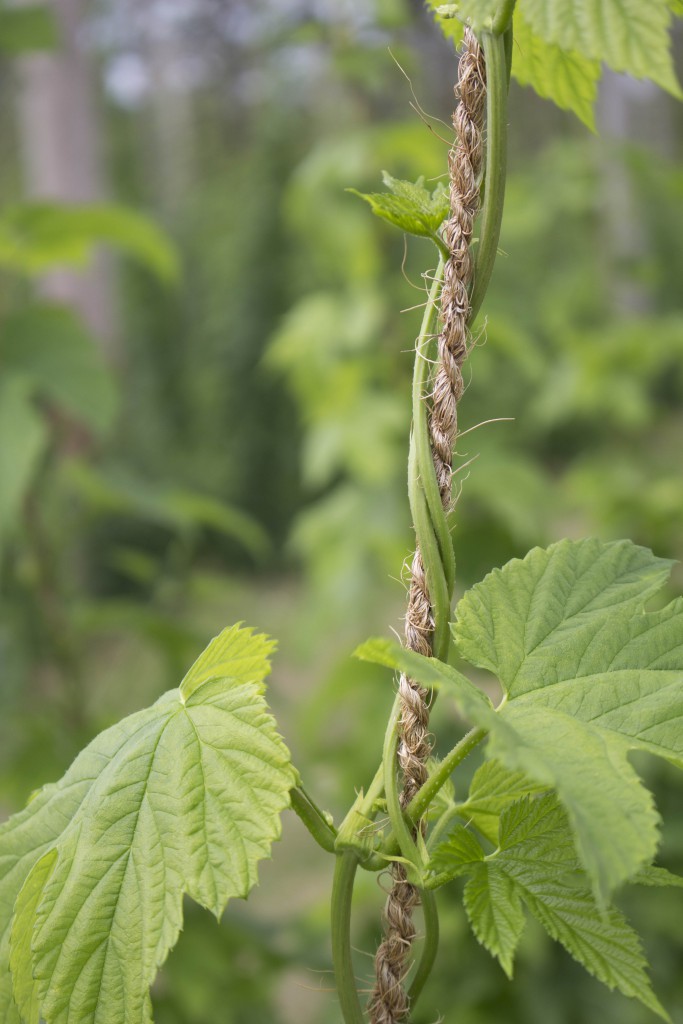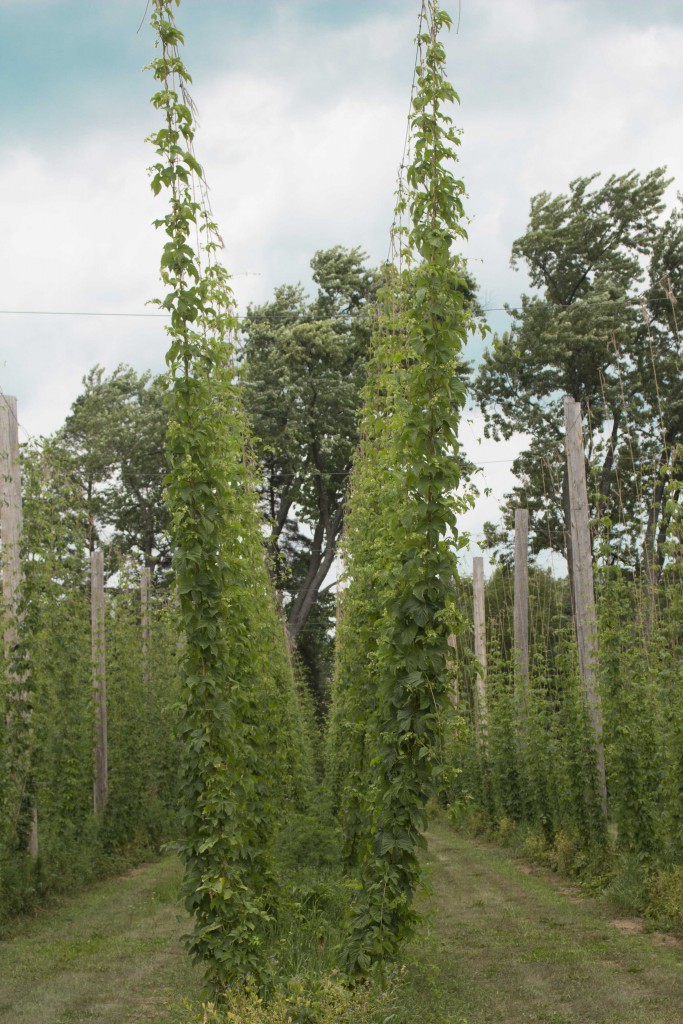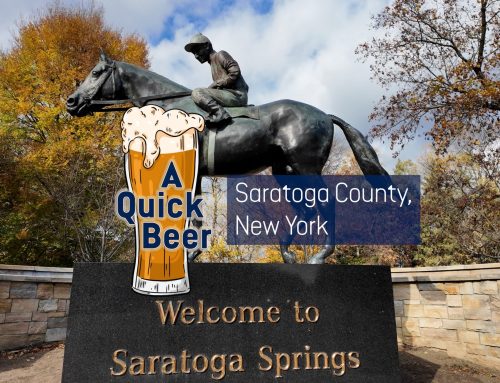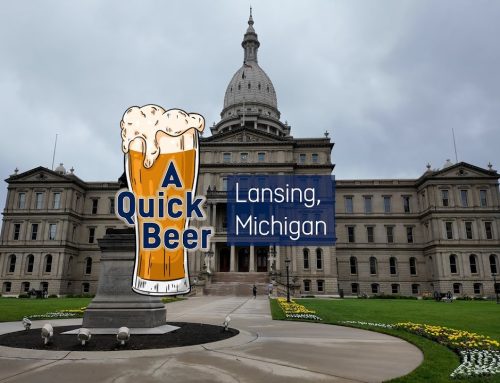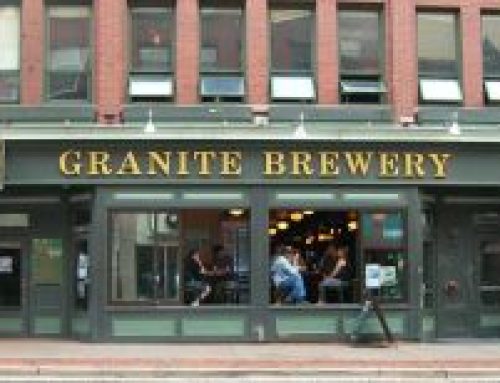Author
Craig
Share
In recent years craft brewing has undergone quite the renaissance. Hundreds of new brewers, thousands of new beers and countless loyal craft beer drinkers. Behind the scenes, a second revolution is starting to take shape: the craft growers, cultivators and producers of craft beer ingredients. As part of a three-part series, I’m taking a closer look at a handful of these less-heralded players in the craft beer industry. First up: Clear Valley Hops.
Located in the heart of the tiny village of Nottawa, Ontario, in the shadow of the Blue Mountains, Clear Valley Hops is a bit of a unique entity in Ontario. For one thing, they’re very well branded. If you take the 124 to Collingwood, you’ll see their trendy sign right beside the road. If you look up their website you’ll find a slick interface, complete with a blog, online store, and all the other bells and whistles you’d expect from a modern website. Perhaps this shouldn’t be too much of a surprise; Clear Valley is the product of John Craig, who once made a living in technology, and Laurie Thatcher-Craig, who worked in advertising and marketing. Ditching their day jobs, the couple purchased the land in 2011 and started producing hops commercially in 2012. The other thing that sets Clear Valley apart is their size. Most hop farms in Ontario are either side projects of farms that mostly focus on other crops, or hobby farms that are just an acre or two. According to the Ontario Ministry of Agriculture and Food & Rural Affairs (OMAFRA), there are about 32 hop growers in Ontario who combine to have a total of 60 acres under cultivation. Clear Valley currently have 13 acres, with plans to expand to 20 and beyond in the coming years.
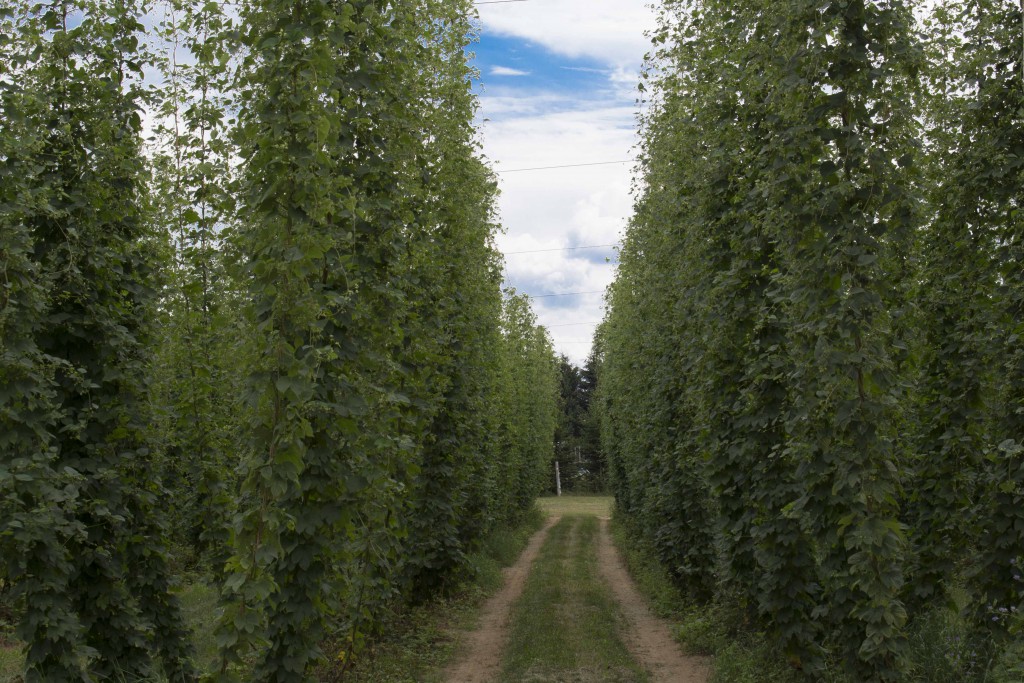
Just one row of many.
By the standards of modern agriculture, hop production in Ontario is currently done on a downright minuscule scale. The average farm size in Ontario was 244 acres in 2011; more than 4 times all the hop farms in Ontario combined. That said, it would be misleading to call hop farming a new industry here. Before prohibition, Ontario and upstate New York were the leading suppliers of hops into Milwaukee, the major brewing centre in the region at the time. At its peak, New York had over 40,000 acres of hops under cultivation. The records for Ontario have been lost over time, but it was considered a substantial producer, so it there were certainly thousands of acres under cultivation. Then came prohibition, along with some crippling diseases and hop production in the Northeast has never really recovered. For the better part of the next century growing hops was largely the concern of European farms. It wasn’t until the American craft beer revolution took hold that hops started to be grown in North America again on any real scale, mostly centered around the Pacific Northwest and in particular the Yakima valley.
In the early days, a large proportion of the growers in Yakima were contracted to deliver their entire crops to the American brewing behemoth, Anheuser-Busch (AB). A few years later AB merged with InBev and all the hop contracts dried up, which inadvertently produced the biggest shift in the hops industry since prohibition. With stiff competition from European growers for traditional varieties, the growers in Yakima turned their focus to the relatively new and fast-growing craft beer industry and started producing massive amounts of the citrus-forward varieties that American craft beer has come to be known for. The rest, as they say, is history.
But what of the Northeast, the former major area of hops cultivation? To be honest, not much happened here until the craft brewing craze took hold in the early 2000s. To support the fledgling industry, the University of Vermont started an agricultural program around the cultivation of hops. One of the artifacts of this program was a manual on growing hops in the Northeast, written by Rosalie Madden. This manual eventually found its way into the hands of the Craigs, who were considering getting into the industry. This manual contained a lot of useful information, but it was geared towards the most common growers in the region at the time: hobby farmers and passion projects. As a result, the widely-used manual was mostly written for tiny farms, which would have no more than one or two acres of hops planted. Laurie and John, on the other hand, approached hops as a business from the outset. Rather than simply doing what everyone else in the region was doing, they set out to see how hops were being cultivated around the world, to try to find a model that would make sense in Ontario.
“The average size farm in Germany is 30 acres, the average size farm in Yakima, Washington is 650. Extremely different models.” Laurie told me, over a picnic table on their farm on a sunny June day. “Our farm, we modelled it after the German model, not the American.” In 2013 they attended the University Of Vermont’s annual hop conference. This conference included feedback from local brewers, which was largely negative due to various factors like mould, insects, and a lack of preservation techniques such as pelletization and freezing. This was bad news for most of the attending farmers. “You could have heard a pin drop in that room because you’re talking major expenditures and you’ve got 2 acres and the math doesn’t add up.” But for the Craigs, this wasn’t news. They had always been thinking bigger, starting out with a plot of land with 50 acres that is suitable for growing hops, and an initial goal to get in the range of the German family farms they were modelling themselves after by cultivating around 20 acres.
Even getting started on limited acreage is a considerable effort. Hops, as a general rule, are not an inexpensive crop. For one thing, you need to have sand or sandy loam for your soil and ready access to lots of water. Hops like lots of water, but will die off if they’re in standing water. For another thing, to be productive you need to be growing in certain specific areas. If you’re under the 40th parallel North the days are too short in the summer. If you’re over the 49th, they’re too long. The Yakima valley is around the 47th parallel and the Collingwood area is around 45, which makes both ideal for growing hops. Once you’ve got suitable soil on a plot of land in the right place, hops have other special requirements, such as the need to grow to a considerable height, which is usually achieved by planting telephone poles with wires hung between them. All said and done, it costs anywhere from 15,000$-50,000$ US to plant an acre of Hops.
Clear Valley started out growing on roughly 13 acres. To do that they need to string 22,00 coconut fibre strings over a three week period every spring. Each string can carry three bines and each of their 11,000 or so plants can support six bines, or two strings. If everything goes well, that produces about 9,000 pounds of dried hops each fall. Their first year was one of the worst droughts the area had ever seen and they lost 9 of their 13 acres. Drought is only the beginning, there are any number of dangers for a crop in Ontario: Downy mildew, aphids, spider-mites and any number of other issues they haven’t even run into yet. “This is not a crop you can be a hobby farmer with” Laurie told me “This crop, I am telling you, if you turn your back for two seconds you will have a problem.” Even worse, since this is so new to Ontario, they can’t even mitigate the risks with crop insurance, because that insurance requires 5 years of yields data. “If a tornado comes over and wipes us out, that’s it. We’re done for. Very high risk – most people don’t understand that.” The end result is a huge amount of risk and a huge amount of work: John and Laurie work about 80 hours a week from spring to fall.
This work is not only spent growing hops. From the moment harvest starts in late August every year, an unforgiving clock starts to get everything packaged in a suitable manner to preserve that precious aroma in the product. Laurie explained: “When this crop comes online for harvest you have approximately a seven day window to do it in to get the peak oils from this plant. If you go too long you’re going to miss it and the product will no longer give a good flavour into the beer. By having 18 varieties what you’re doing is making sure your harvest window is nice and wide.” Since different varieties matures at different times, having 18 varieties instead of planting only what sells best, which would mean planting nothing but cascade, they can spread out the labours of harvesting the hops and produce more while maintaining their freshness standards.
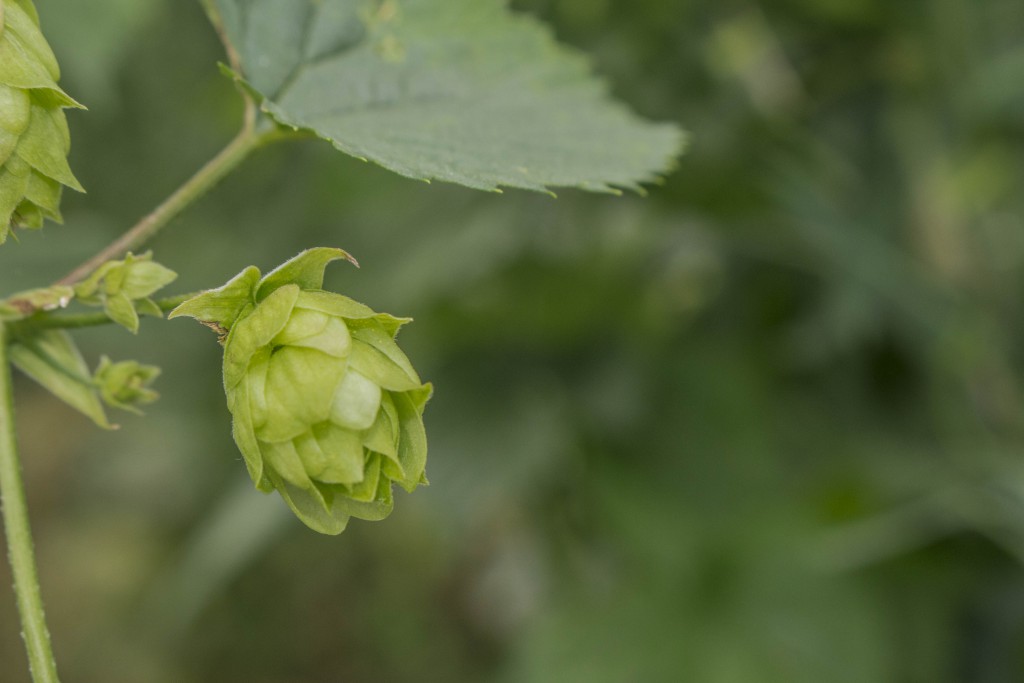
What it’s all about. Lots and lots of these.
A lot of energy goes into producing the freshest possible hops. The first challenge is drying the hops, which they approached by building an oast. Theirs is a replica of oasts from Sussex, except with the structure made of dense cinder-blocks which temper the wild swings in the Ontario climate. “The Americans and Europeans dry their hops at 150 degrees Fahrenheit. Research from Oregon State University found that when you do that, you’re cooking out all the essential oils. Essential oils immediately degrade after 120 degrees Fahrenheit, so our Oast is drying the hops at 115 degrees.” An oast is basically a structure with a roof that turns naturally in the wind, causing an updraft which sucks warm air up through the hops. It’s an old, but effective technology.
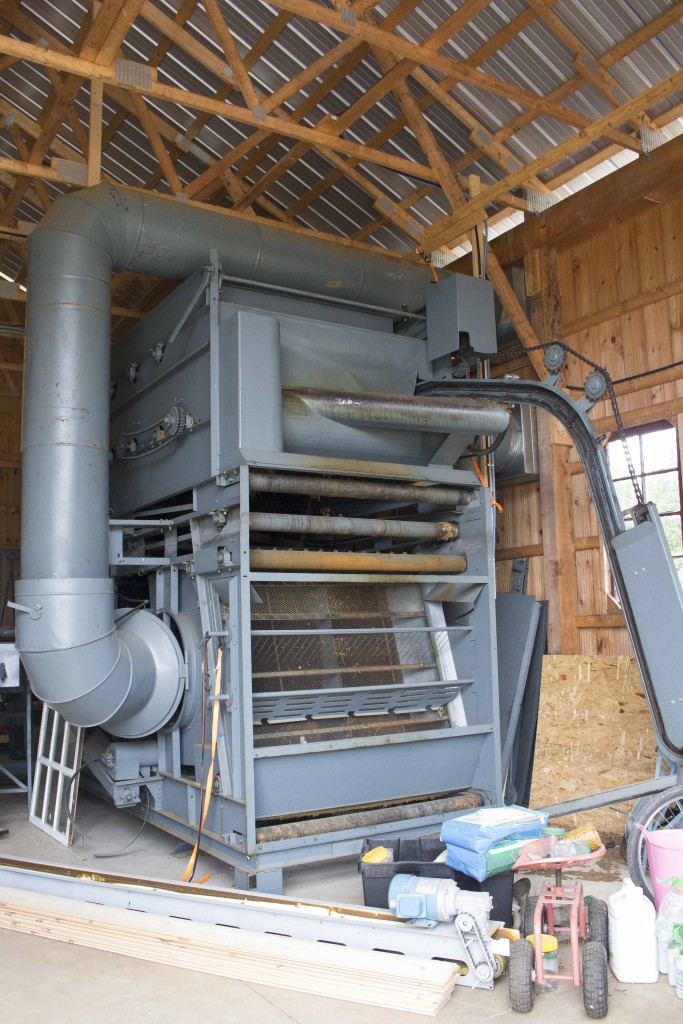
Their 1973 Hopenflucker. “It’s a beast of a workhorse.” This beast pulls the hop flowers of the bines and drops them on a conveyor belt, which deposits the hops in the oast.
Unlike the larger American hop farms, where crops are compressed into bales and warehoused for extended periods during which light and oxygen can ruin flavour-producing oils, the goal at Clear Valley is to pelletize, vacuum seal, nitrogen flush and flash freeze hops within 24 hours of harvest. Even the packaging has been given special attention. “We worked with a company in Manitoba to create a bag that blocks UV light and oxygen completely once they’re put into it, so it preserves the hops for years. We have, I believe, the freshest hops in the world.”
This attention to every detail of the process of getting a quality product out is truly representative of people who take the term craft to heart. Rather than focusing on productivity or profits per acre, a craft producer is primarily interested in producing the best product they can, then putting it in the hands of people who know what to do with it. Laurie acknowledges that working their way into a market that is so used to importing all their hops was no small feat. “We’re very focused on our breweries in Ontario. Making this viable. Demonstrating (hop farming) can be brought back into Ontario.” It turns out this wasn’t actually easy, but one brewery in particular took a chance on them:
No-one believed we could do it. It’s been very very difficult. I always tell everybody I give a huge credit to Joel Manning at Mill Street. No-one would really have much to do with us. One day I sent out little samples in the mail to all these breweries to show them what we could do – it was cascade – and Joel Manning told me this story. He said he was away on holidays for a couple of weeks and that package sat on my desk. It wasn’t frozen, it wasn’t refrigerated, it sat on my desk for weeks. He said he came back from holidays and they laughed, they thought they were going to smell mould. He opened it up and he said he fell off his chair, his brewmaster fell off his chair and he says ‘Laurie I couldn’t pick up the phone fast enough to find up what you guys are up to’. He came out right away…He said ‘We’re here. Mill Street is here for you and we’re going to stay with you’ and it was the best news I had heard. He was the first to have any confidence in us.
Since then, their portfolio of brewers has grown considerably. It includes the likes of Amsterdam, Lake of Bays, Wellington, Boxing Rock (out of Nova Scotia), Dominion Brewing, Niagara Teachers College, the newly launched Tobermory Brewing Compay, Maclean’s Ales and Revel Cider, who have basically monopolized the crop of the mysterious Hop X for their excellent dry-hopped ciders. Even if they are the biggest hop farm around, Clear Valley is still a fairly small operation, which would be hard pressed to supply all the hops for a widely distributed beer. Instead, they try to establish a relationship with brewers who are willing to experiment what they have available. This collaboration with brewers lends itself well to seasonal or one-off releases that produces things like a saison dry-hopped with nugget for Dominion City and the Lake of Bays Far North series. According to Laurie “one-off stuff is ideal for your local growers because I can’t grow everything that everybody wants at the same quantity. It’s better for them to work with me to work with what I have. ”
The reward for working with them is access to a fairly unique product. Hops are a product that very much has terroir; East Kent Goldings grown outside of Kent just doesn’t taste the same as it does in its homeland, nor does Hallertau grown outside of Bavaria. What exactly defines the Ontario terroir is still being discovered, but the early results tend toward citrus, which is a good thing in the current craft beer scene. Laurie swears that her Willamette, a variety normally associated with floral and spicy notes, comes in like orange marmalade. Perle, a German hop, comes in like lemon meringue pie. Since ordering from Clear Valley won’t produce textbook flavours, they figure that the best thing for a brewery to do is visit.
The real craft brewers that take the time to come and see us and understand what we’re doing here and understand our packaging policy and understand the environment that we’re all in to give them the best fricking quality in the world. The brewers that come out here and talk to us and learn all this stay with us. If there’s one message I want to get across it’s that they need to do this. They need to educate themselves as to what happens on this farm and how important this product is to their business model. I don’t want you buy me just because I’m “local” I want you to buy from me because I’m giving you the best product on the market for your money. And we believe that. We believe we are giving them the best product on the market.
When I first reached out to them to be featured in this article, I was a little worried that I would be imposing on them. I figured that in the current hyped-up craft beer environment in Ontario and what with Clear Valley being the biggest and, in my opinion, most interesting hop growers to appear on the Ontario market in a long time, they would be getting a lot of media attention. As it turns out, this wasn’t the case. The focus these days remains squarely on the brewers. Outside of a few local papers, not many people have really come calling on Clear Valley to learn more about what they’re doing. This is a shame. Knowing of and rewarding local producers can only encourage more and better local production, which I believe will ultimately produce better local beer.
For their part, Clear Valley are actually doing a pretty good job of reaching out. They have a respectable website and they update their Facebook and Twitter accounts regularly. They even maintained a blog that goes into greater detail on specific parts of their operation. As an added bonus, Clear Valley will actually deal with individual buyers! They have an online store where you can buy any of their available hops in sizes ranging from 4 ounces to 11 pounds. The easier route for a farm would be to simply sell directly to brewers and maybe a few homebrew supply shops, since packaging and shipping for individual customers is often more hassle than it’s worth. Better still, last year Clear Valley started selling hop rhizomes, which is terrific for the home brewer with some space in their back yard. I’m not personally familiar with the economics, but I can’t imagine that selling rhizomes to home brewers does anything like the volume to merit the effort. I suspect they do it just because they just think it’s great that people are interested. (A word of warning: rhizomes sell out. E-mail them the winter before you want to plant and they’ll put you on the list.)
One of the things that needs to happen for the Ontario craft beer industry to take that next step forward is people who are currently into craft beer, particularly the people who are deep enough into craft beer to read to the end of this article, need to take an interest in the local industry beyond the brewers. Get out there and decide for yourself who makes the best ingredients around. Clear Valley offer free tours of the farm on weekends, which I highly recommend, especially if you’re in the Collingwood or Wasaga Beach area anyway in the summer. It’s a great way to learn more about them and what they do, plus Laurie is more than happy to answer any questions you might have. The best part though, for a beer geek and home brewer like me, is at the end they just set you loose to explore the farm on your own. Picture yourself on the back farm, mountains in the background, surrounded by rows of hops as far as you can see, without another soul in sight. It’s worth checking out.
